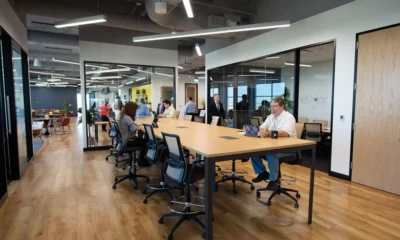Business
Could Teleworking Post COVID-19 Make People Drive More?

Throughout the COVID-19 pandemic, many companies have transitioned to work-from-home structures that kept people safe in their houses while work continued. As restrictions loosen, lots of employees are continuing to telework at least a few days a week.
At the broad level, most people would assume that this change is going to lead to people driving less overall. This seems like a win for the environment, but what if it’s not necessarily true?
Some data suggests that teleworkers might actually end up driving more while teleworking than they did while working in an office. Of course, there’s no way to know for sure what the future will look like, but let’s look at some reasons why teleworking post-COVID-19 could lead to more driving rather than less.
Table of Contents
Post COVID-19 Driving: More Or Less?
It’s hard to get a clear look at whether or not people will be driving more or less as the pandemic gets more and more under control. Early statistics show that, surprisingly, people may be making more trips not less, but there are many instances of conflicting data as well.
When considering whether or not teleworking may cause people to drive more, all of the following needs to be taken into consideration.
More: No More Side Errands
While many people have stopped going on their daily commute as they worked completely remotely, this meant that they needed to take other trips to do things like grocery shopping, picking up medications, or running to the doctor.
In the past, many of these trips might have been tacked onto a commute, so there would be less overall driving down. However, whether or not this leads to more or less driving is very dependent on location, commute distance, and individual preference.
Less: Saving Money
As some people realized just how much less they were driving and likely would be driving into future months, some took the opportunity to look into work-from-home car insurance that would save them more money.
There are some types of car insurance plans that allow you to pay less money each month as long as you do not cross a certain insurance mileage limit. Since you are driving less, there is a lower risk that you will be in an accident so your rate can go down.
Those who transition to full-time teleworking may see a reduction in their annual mileage, leading them to greater savings on the car insurance front.
More: Former Transportation Changes
Many workers who previously commuted to the office each day used public transportation to get to their work hub. From there, they might walk around to complete their errands or have meetings out of the office each day. This is especially true in cities or other large hubs.
These same people may be transitioning to teleworking, which doesn’t always equate to the same access to public transportation options depending on where you live.
This means that you may be driving more to complete errands or go to meetings, and this could lead to you driving more than you use public transportation in the long run.
More: Spreading Out
Many families took the COVID-19 pandemic as a good motivator to spread out and move into more suburban or even rural areas. While this may have been a great choice for their family lifestyle, it can definitely lead to more driving. Those who live in these areas tend to need to drive more for basic necessities, which can add up over time.
Why Are Companies Staying Remote?
One question that many people who are unfamiliar with is how teleworking changed things during the worst of the pandemic is why? Why are companies focused on building a remote workforce rather than trying to get their employees back in the office?
Ultimately, there are too many reasons to concisely list.
Many sources have found that working from home at least a few days a week has major benefits like improving mood, productivity, and work happiness. Additionally, companies are finding that they are able to save money and work more efficiently with this change.
Finally, many people simply like it better, so they ask their companies to consider switching to a hybrid or work-from-home model long term. While some employees are ready to get back into the office, others do not want to lose the joy and freedom that they have found at home.
The Bottom Line
The bottom line is that we still don’t know what will happen following the COVID-19 pandemic. While we’re sure that the face of work has changed forever, in what ways will these changes last? Will people continue to want to telecommute indefinitely, or will that change, too?
Until things become more clear, there is no way to say for certain whether or not people will drive more. While right now it seems that people are driving much more than usual as things reopen, this could be a resurgence caused by the newfound freedoms that people want to explore.
As time goes on and things flatten out more, we may see a return to driving situations more similar to what was going on before COVID-19 first showed up.
There’s only one thing for certain: only time will tell!

-

 Business4 years ago
Business4 years agoHow to Do Long-Distance Moves with Children
-

 Business2 years ago
Business2 years agoThe Ultimate Guide To Thriving In Your Printing Franchise
-

 Business2 years ago
Business2 years agoExploring The Benefits And Challenges Of Restaurant Franchising
-

 Tech4 years ago
Tech4 years agoCyber Table That Will Change Your Life
-

 Business5 years ago
Business5 years agoIs Guest Posting a Good Inbound Marketing Strategy?
-

 Lifestyle2 years ago
Lifestyle2 years agoDallas’ Hidden Gems: 6 Must-Try Restaurants Off The Beaten Path!
-

 Lifestyle3 years ago
Lifestyle3 years agoTop 10 Restaurant Franchises In The US
-

 Business2 years ago
Business2 years agoTop 10 Reasons You Should Invest In A Coworking Franchise













Recent Comments